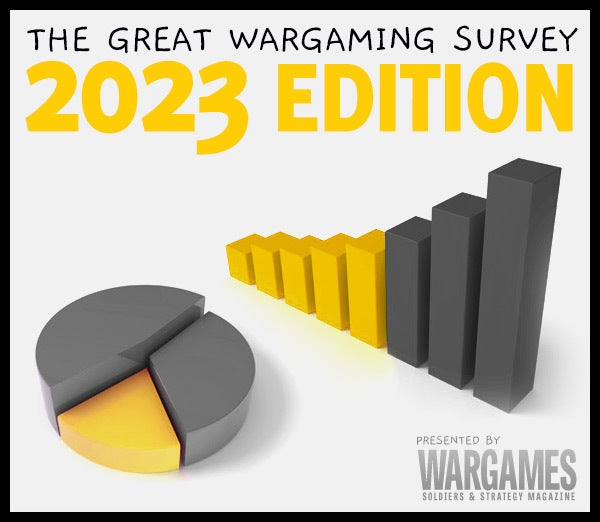American wargamers according to the Great Wargaming Survey
Having reported on wargamers in my native Netherlands, I figured it’d be fun to check out what wargaming is like across the great blue Atlantic, in the United States. As always, this just reports on the respondents to this year’s Great Wargaming Survey, and ‘the average wargamer’ should be understood as the average according to the survey. Disclaimer aside, let’s have a look at the wargaming population of what is now probably the most polled nation in the world…
Just under 30% of 9997 respondents to the survey indicated they live in the United States of America. Genderwise, they are exactly average with 1.9% female and therefore 98.1% identifying as male. On average they are a bit older, with 59% over 40. Interestingly, the age-groups most deviant from the average are the 31-40s and the over 60s. The latter group is considerably larger in the US (11% vs 6.6% average) and the former is comparatively smaller (22.4 vs 27.9%). Because of the size of the population, it might be interesting to compare the ‘younger’ (under 40 - about 1100 responses) and ‘older’ (over 40 - about 1700 responses) groups.
A generation gap?


During the survey, I already established (sort of) that ‘the age of historicals’ is 42 (in answer to this video), and looking at the data for American wargamers seems to reinforce that notion. In fact, one might wonder if there’s a generation gap. Gaming preferences certainly seem to be divergent. See for instance the two tables left and right (click to enlarge the images). On the left, the period or setting preferences for the younger group, on the right, those for the older group. The scale goes from ‘not interested’ (light green, left) to ‘very interested’ (dark blue, right). It’s immediately obvious that the general interests are very different. The younger group has Sci-Fi, Fantasy, Pulp and Alternative History all proudly in the top 5, with World War 2 as the lonely historical group in third place. For the older group, Sci-Fi is the only one to maintain itself in the top 5, which now includes the ACW, Napoleonics and the Medieval Era. The latter, interestingly, is in sixth place for the younger group, but you’ll have to go quite far down the list to find Napoleon, Grant and Lee.
Gaming groups


What about the composition of the gaming groups? We asked several related questions which might be helpful. Solo wargaming is preferred by only a small group (just under 5%) of younger wargamers, and by more than twice as many older wargamers (over 12%). The younger gamers proportionally play in more small groups (43%, 1-4 others) or large groups (13%, 10-15 others). For those same younger players, 52% indicate the people in their groups are about their own age or younger. 11% are in a group where most players are older and 37% have groups whose members are very mixed. Only 2% percent of the older group plays with gamers ‘even older’ than they are, 16% with younger gamers (which apparently often includes family members), 41% with players of their own age (which includes the solo gaming ‘group’), and 42% with a mixed group.
Those gaming groups play at somewhat different locations (multiple answers possible to this question!). On the left, it’s immediately obvious that the FLGS has an important role to play for younger gamers with nearly 70% indicating they generally play there, against only 49% for the older group. They, on the other hand, play comparatively more often at conventions and in the comfort of their own home. It’s probably no stretch to state that both of those are a factor of disposable income for travel and man-caves.
A grey hobby?
So where does all this take us? First of all, let’s look back at the previous editions of the GWS. We can’t look specifically at American wargamers for 2014 and 2015 (at the time we asked for regions, not countries), but in those years 2805 and 2787 wargamers respectively indicated they were North-American. Last year, 71% said they had not taken part in 2014 and this year 67% stated as much. In other words: though there is clearly a substantial group that has taken one or more surveys in a row, the majority has not. If the results remain similar year upon year, that may mean they are more broadly valid than for just the respondents. Second, the share of ‘under 40’ North-American gamers was 37% in 2014, 45% in 2015 and 43% in 2016 (with apparently a slightly older population in the US than in Canada! - see above). We may have to await 2017 and 2018 for a trend, but this doesn’t immediately look like a ‘greying of the hobby’. However, if your personal experience is different, that may have something to do with a generation gap. In very broad terms, younger gamers have different preferences than older gamers, play in different locations and with people of their own age and younger. Obviously there are lots and lots of exceptions, but if you only see grey heads in your group, you may just have to look for a group of younger gamers. They might be at the FLGS, playing a not-very-historical game, but a miniature wargame nonetheless!



